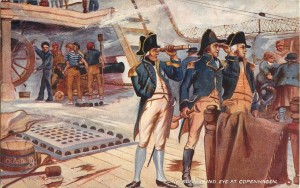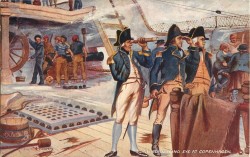 How risk can be good, and why we need more of it
How risk can be good, and why we need more of it
Fortis fortuna adiuuat. So wrote the 2nd-century B.C. playwright Terence of the Athenian general Phormio who, facing a numerically far superior Peleponnesian fleet, tricked them into self-defeat through an unusual, highly risky corralling tactic. Once the enemy fleet’s oars were hopelessly tangled, Phormio seized the advantage, rushed in, and won the battle.
Fortune favors the bold.
More recent naval history agrees. Stephen Decatur’s gamble of a sneak attack on the captured USS Philadelphia in the early 1800s was termed “the most bold and daring act of the Age” by no less than Admiral Lord Horatio Nelson – an officer who knew something of bold and daring naval acts, having triumphed at Trafalgar with highly unconventional tactics of his own.
In World War II, Admiral Nimitz rushed barely patched-up ships to the Battle of Midway in a chancy yet ultimately successful move that defeated a numerically-superior Japanese force, thus turning the tide in the Pacific theater.
It’s clear risk can be good.
However, in the half-century since our country was last seriously challenged in combat at sea, our military has developed what Tim Kane in The Atlantic terms a “zero-defect mentality.” This relentless insistence on flawless performance induces upwardly-mobile leaders to cling to safe, middle-of-the-road blandness, shunning risk.
Today’s enemies are bold and daring, often blatantly unconstrained by the rules of engagement, red tape and resource constraints that entangle us. If we do not seize the initiative early and often, they will win.
Our Sailors, Marines, and Coast Guardsmen continue to innovate, defying convention to defeat our foes. Yet our military has become so confused about risk that a successfully innovative leader is more often punished or pushed out than promoted, while paradoxically, thrill-seekers get cheered for dangerous demonstrations of “confidence.”
We must dramatically change our approach to risk. Instead of implying all risk is bad, we must carefully educate our corps on the difference between good and bad risk. Then, as leaders, we must encourage innovation and good risk while eradicating bad risk and recklessness.
The first objection to bold, innovative leadership stems from this zero-defect mentality we’ve cultivated. Won’t risky actions cause mishaps, resulting in casualties and property damage?
The obvious answer is yes, sometimes: sometimes risks fail, and sometimes lives and property suffer. Admiral Nimitz, when an ensign, ran his ship aground. Admiral Nelson’s career was littered with failures, including the stinging defeat that took his right arm and many lives.
But, over time, intelligent innovation saves lives and prevents injuries. This is evident not only in large-scale operations like Decatur’s raid, accomplished without a single casualty, but in more localized innovations like the Holley stick. Essentially a long stick using simple means like a hook to catch IEDs, this simple yet highly effective tool, invented recently by a Marine in Afghanistan, prevents serious casualties every day.
“If we are too risk-averse to adapt, then in the long run, we make ourselves more vulnerable,” says Marine Corps Capt. Jerome Lademan, a member of the Chief of Naval Operations Rapid Innovation Cell (CRIC). “The enemy won’t wait on us to develop better weapons, systems or tactics.”
But surely, risk wastes money. As budgets shrink, can military services afford to take risks?
The better question is, how can they afford not to? In the long run, innovative processes and products save the military significant quantities of money.
Six years ago, Navy Lt. Rollie Wicks, innovation cell member and a Chief Network Scientist at the Under Secretary of Defense, Acquisition, Technology and Logistics, urged the Navy to replace its towering stacks of hard-copy maps, charts and targeting imagery aboard ship with equivalent online resources. Sailors were so overburdened and short on storage space, they often threw out new materials as soon as they arrived. Yet, the tradition-bound Navy was highly reluctant to risk relinquishing these trusted paper copies. Wicks ultimately won, and the resulting electronic Geospatial Product Library now saves the military millions of dollars and thousands of personnel hours annually.
“Now is the time to quit throwing funds at bad ideas and the wrong people,” Wicks says. “The military needs to identify the ‘risk takers,’ surround them with the right mentors, and fund them to innovate.”
A final, frequent, objection to risky action is that it defies convention. The military, papered over in piles of checklists, often worries innovation is nothing but insubordination. So, why promote it? Won’t risky behavior undermine the military’s good order and discipline?
It is true that even such an impressively successful leader as Nelson was often tarred by his superiors as insubordinate. In the Battle of Copenhagen, trusting his tactics, Nelson famously disregarded a command signal to retreat, claiming he never saw it…after intentionally putting the telescope to his blind eye. Nelson prevailed, in the decision and in the battle.
Innovative military leaders probably will never leave their superiors completely at ease.
But by educating our forces on the different types of risk, we can keep leaders from fearing their subordinates’ potentially unpredictable actions. Instead, leaders can trust their subordinates will confidently seize the initiative, acting boldly on a solid basis of experience and skill learned from their elders, and employing a keen intuition honed by repeated front-line faceoffs with their foes.
They will know and trust that fortune favors the bold.
Too often, we define “calculated risk” as simply avoiding risk. Common military risk-assessment tools use numerical scales that suggest high risk is always bad, and low risk always good, often leading to a “green-washing” of all situations as low risk. Then, without proper understanding of risk, reckless behavior tends to proliferate while innovation is discouraged.
We must reverse this debilitating trend if we intend to outwit, outmaneuver and ultimately conquer our many 21st-century opposing maritime forces. Instead of reducing risk to a simplistic equation of numbers or, worse, a series of stoplight colors, we need to educate our troops on the important difference between good and bad risk. Then, we must relentlessly encourage innovation while working tirelessly to eliminate recklessness.
It is time to replace “risk reduction” with “risk promotion.”
As Navy Petty Officer First Class Jeff Anderson, CRIC member and Electronics Technician on the USS Independence, points out, “Wars require the risk takers in charge, not the risk-averse.”
In other words, fortis fortuna adiuuat.
U.S. Coast Guard Lt. Heather Bacon-Shone is a member of the U.S. Navy’s Chief of Naval Operations Rapid Innovation Cell (CRIC). The CRIC, hosted by the Naval Warfare Development Command, is composed of hand-picked junior officers and mid-grade enlisted personnel and civilians who partner in innovation with leaders in business, industry, and the military in order to solve tomorrow’s naval problems today.
The views expressed herein are those of the author and are not to be construed as official or reflecting the views of the U.S. Coast Guard or U.S. Navy.


After 35 years as a Naval Officer, LLNL Engineer and DOE consultant I have observed the bureaucratization of our society/culture until today it seems essentially, ossified, dysfunctional. I am guessing we have less than 300 afloat assets today and I will also guess 1M + clerks at all levels trying to help……during Viet Nam years 40 years ago we were so swamped that some COs had the Yeomen toss all snail mail from fed clerks, especially those with WDC zip codes, clerks,…..never opened it……we felt if it was important a message would proceed any paper. They never recognize we were fighting a war…..seriously… It was gross….as the feds become the employer of last resort in Depression II the helpers have grown massively. Once in place the culture has a life of its own …a Hydra with infinite tentacles and rampant growth daily.
This is precisely what tanked the USSR….not the COLD WAR pseudo win by USA ……….clerks……it is our death knell……..
Kick ass Heather. You have my vote for Commandant.
I 100% agree that risk aversion is bad for an organization that is supposed to win wars, and processes that serve only to perpetuate the existence of a particular bureaucracy don’t help. Having said that, there is another side to the story. There are lots of good ideas out there…but they’re never free. Taking risks in combat is one thing, coming up with a better mousetrap and leaving someone else with the bill (how is the service supposed to pay for it?) isn’t risk-taking.
this is a nice piece. hope you all get to continue this work. it should be the norm.
Some previous thoughts on leadership, command, and risk:
http://www.usni.org/magazines/proceedings/2012-09-0/leadership-command